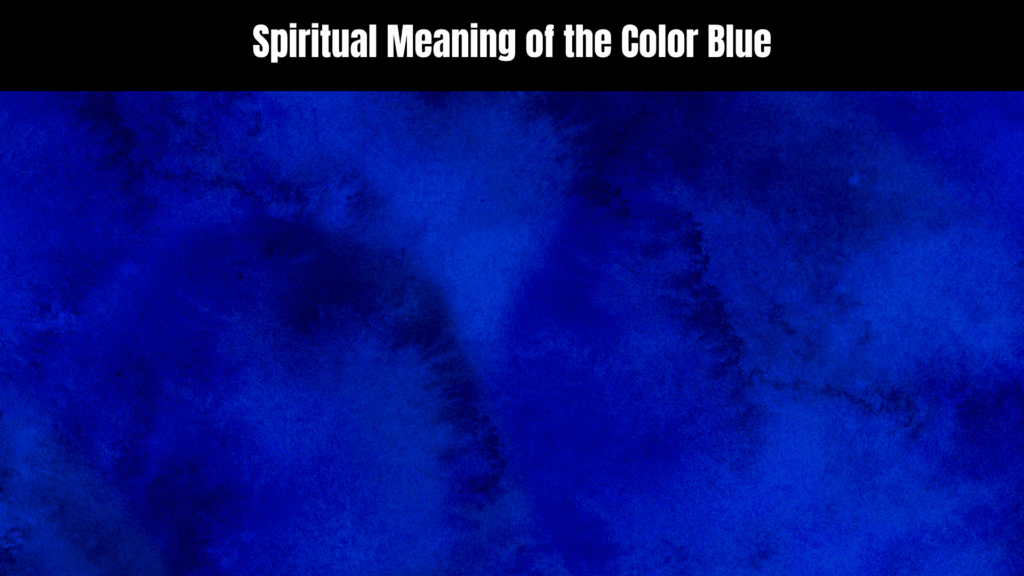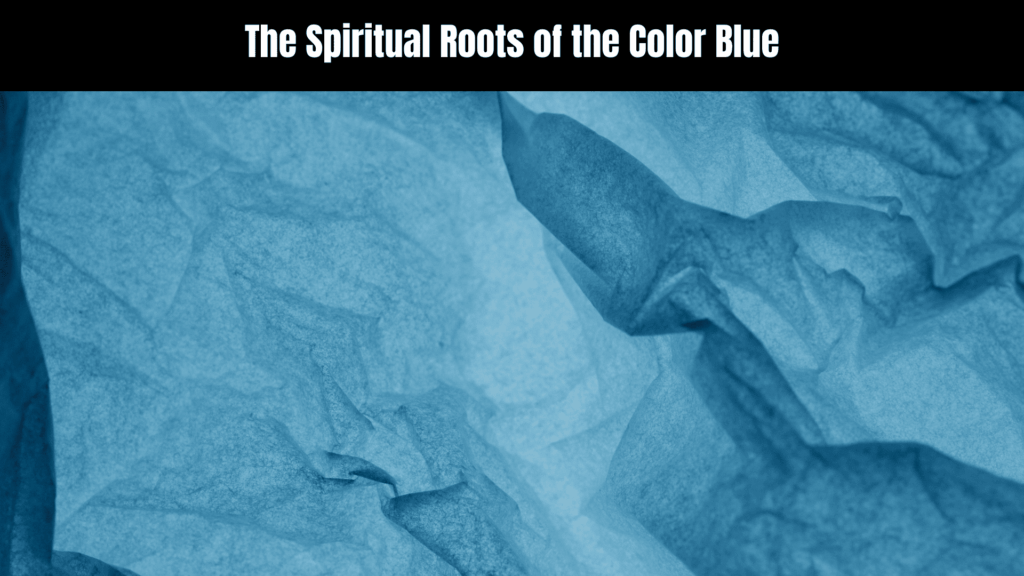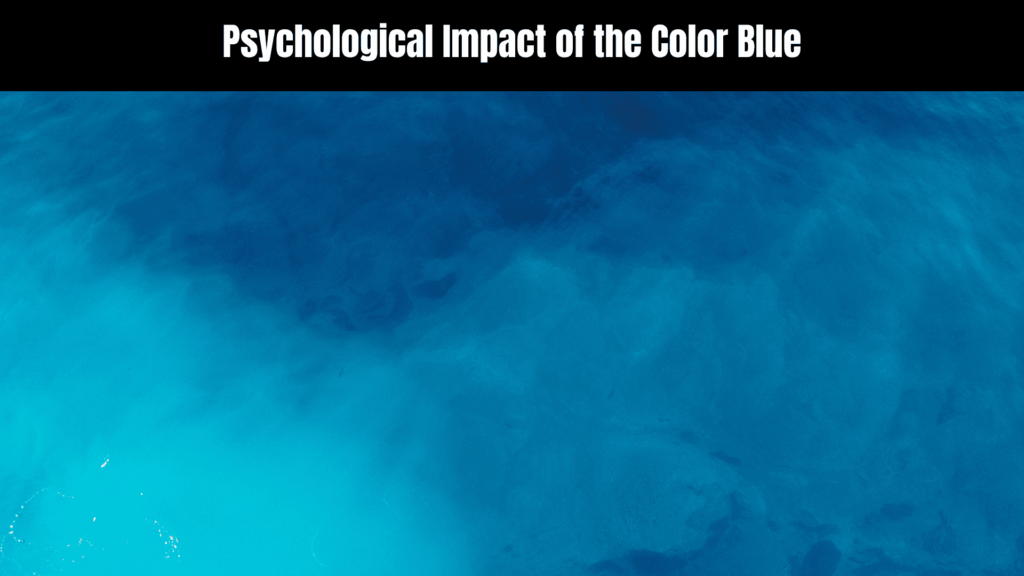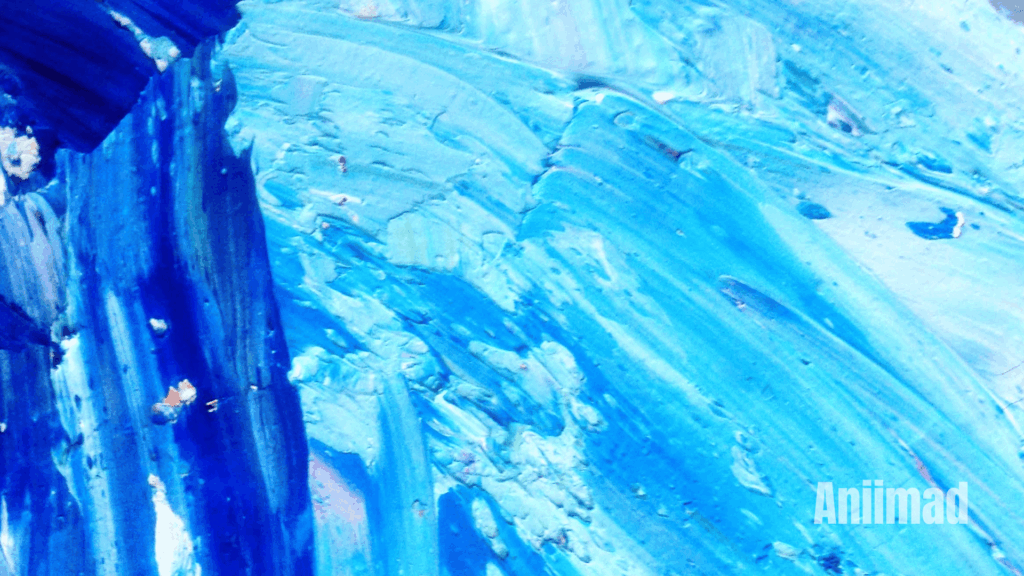Spiritual Meaning of the Color Blue
Introduction to Color Symbolism in Spirituality

The Power of Color in Human Consciousness
Colors have always spoken louder than words when it comes to emotion and energy. Long before we had names for them, colors were used to paint stories, signal danger, and calm restless hearts. But there’s more to colors than just what we see with our eyes—they touch something deeper. Spiritually, colors are believed to carry vibrations that influence our thoughts, feelings, and even our soul’s path.
The color blue, in particular, has long been associated with depth, wisdom, calmness, and the vast expanse of both sky and sea. Its spiritual meaning is rich and layered, reaching across ancient traditions, modern interpretations, and personal transformation.
Why Blue Holds Special Spiritual Significance
Blue symbolizes both stillness and movement. Think of a calm ocean versus a roaring tide or a clear sky versus a brewing storm. In spiritual practices, this duality represents balance—something every seeker aims to achieve.
The spiritual meaning of the color blue is often tied to truth, clarity, and open communication. It resonates with calm energy and invites you to look inward, discover your truth, and speak it with grace. This makes it a powerful color for those on a spiritual journey of awakening or healing.
The Spiritual Roots of the Color Blue

The spiritual significance of the color blue runs deep—across time, cultures, and belief systems. Long before blue was understood as a wavelength or pigment, it was revered as a divine sign, a link to the heavens, and a protector of souls. Let’s dive into its ancient beginnings and see how blue became one of the most spiritually significant colors in human history.
Ancient Civilizations and Their Blue Symbolism
In ancient times, blue was not just a color—it was a sacred experience. Few natural blue dyes existed, making the color rare and valuable. Because of its rarity, blue was often reserved for religious leaders, royalty, and sacred rites.
Egyptian Blue:
The ancient Egyptians were among the first to create a synthetic blue pigment. Known as “Egyptian Blue,” it was used to decorate tombs, statues, and ceremonial objects. To them, blue represented the sky and water, which were essential to life and rebirth. Blue amulets were placed with the dead to guide and protect the soul in the afterlife.
Mesopotamian and Sumerian Culture:
In ancient Mesopotamia, blue stones like lapis lazuli were crushed into powders and used in art and makeup. The stone symbolized wisdom, royalty, and divine favor. Kings and priests wore it to reflect their connection to the gods.
Mayan and Aztec Civilizations:
In Mesoamerica, blue was connected to the rain god and fertility rituals. The sacred pigment “Maya Blue” was used in temple murals and offerings to deities. It was considered a bridge between the earth and the spiritual world—linking the physical to the mystical.
Blue in Mythology and Sacred Artifacts
Many mythologies across the globe use blue to signify sacred energies, divine power, and otherworldly presence.
Hinduism:
Some of the most revered deities—Krishna and Vishnu—are portrayed in blue. This isn’t due to their physical appearance but rather their cosmic energy and eternal nature. Blue symbolizes the infinite, like the boundless sky or deep sea, making it perfect for gods who transcend space and time.
Greek Mythology:
Poseidon, the god of the sea, was closely tied to blue. The ocean’s ever-changing, yet calming energy reflects both power and serenity, much like blue’s dual spiritual nature.
Christianity:
Blue holds a prominent place in Christian symbolism. The Virgin Mary is often shown wearing blue robes, signifying purity, protection, and heavenly grace. During the Renaissance, blue pigments were so expensive that churches spent fortunes on lapis lazuli paint to depict holy figures in blue, elevating their spiritual importance.
Judaism and the Tallit:
In Jewish tradition, the tallit (prayer shawl) often includes a thread of blue, known as tekhelet. This blue is mentioned in the Torah as a sacred color representing obedience to God, moral clarity, and divine law.
The Color Blue in Sacred Texts and Teachings
Across various religious texts, blue surfaces as a marker of truth, clarity, and divine presence.
- In the Bible, blue is mentioned frequently in descriptions of the tabernacle and priestly garments. It symbolized heaven, law, and spiritual insight.
- In Buddhist texts, the Medicine Buddha is described as being deep blue in color, associated with healing and enlightenment.
- In Islamic culture, especially in Persian and Ottoman traditions, blue is featured in mosques and holy art, believed to ward off evil and reflect divine beauty.
Blue as a Universal Spiritual Messenger
What makes the color blue so universally powerful in spiritual contexts is its connection to the elements: sky and water. These vast, immeasurable realms represent freedom, higher consciousness, and purity.
Spiritually, blue often conveys:
- Communication with higher realms
- Peace and mental clarity
- Inner truth and divine order
- Ethereal protection and guidance
Even today, many people who undergo spiritual awakenings report seeing flashes of blue light, which they interpret as signs of angelic or celestial presence. Blue is also a common color associated with aura readings, where it symbolizes calmness, sensitivity, and intuitive insight.
Psychological Impact of the Color Blue

The color blue is more than just pleasing to the eye—it has a profound psychological effect on the human mind and spirit. It is often described as a “cool” color, but its influence is anything but cold. In fact, blue is widely recognized for promoting calmness, encouraging deep thought, and healing emotional distress. From ancient wisdom to modern science, blue continues to be a color that balances the emotional and mental self. Let’s explore how blue affects us psychologically and spiritually.
Calmness, Peace, and Serenity
One of the most immediate effects of blue is its ability to induce calm and tranquility. This is why blue is so often used in hospital rooms, meditation spaces, spas, and bedrooms. It has a natural capacity to slow the heart rate, reduce stress levels, and promote relaxation.
How Blue Triggers a Calming Response
Blue’s association with the sky and the ocean makes it a symbol of vastness and openness. When people see the color blue, it triggers their brain to associate it with safe, expansive environments. This promotes feelings of freedom, stillness, and openness, reducing feelings of anxiety and chaos.
In clinical psychology, the presence of blue has even been shown to lower blood pressure and respiration rates. It doesn’t overwhelm the senses—it soothes them. That’s why it’s such a powerful color for emotional regulation and spiritual mindfulness.
Spiritual Implications of Blue’s Calm Nature
Spiritually, this tranquility translates to inner peace. When blue dominates your visual environment—whether through clothing, surroundings, or visualization—it nurtures a state of emotional stillness and mental clarity, opening the door for prayer, reflection, and healing.
Emotional Healing and Mental Clarity
Blue is also known for encouraging emotional healing and mental focus. If you’ve ever stared at a blue sky while deep in thought, you’ve already tapped into this benefit. Spiritually and psychologically, blue invites introspection.
Healing Through Emotional Expression
Because blue is connected with the throat chakra, it facilitates healthy emotional expression. When this chakra is balanced, individuals can articulate feelings clearly and honestly, which is a major step in emotional release and recovery.
People struggling with suppressed grief, guilt, or anxiety often find comfort in blue. It gives them the space and serenity needed to process deep emotions without feeling overwhelmed.
Mental Clarity and Focus
Mentally, blue enhances concentration and organization. This is why you’ll often find blue in offices, study areas, and libraries. Unlike brighter, more stimulating colors like red or orange, blue slows down mental chatter and supports focused thinking.
From a spiritual lens, this mental clarity helps individuals connect with higher consciousness and universal truths. It allows them to sift through the noise and hear the voice of the soul.
Blue as an Anchor in Stressful Situations
In high-stress environments, blue can act as a psychological anchor. Studies have shown that people in blue-lit rooms perform tasks more efficiently and report lower anxiety levels. Emergency services and airlines often use blue in uniforms and branding for this very reason—it inspires trust, confidence, and calmness.
Spiritual Stillness in Chaos
On a spiritual level, blue serves as a beacon in times of emotional or energetic chaos. Whether through guided visualizations or simply surrounding oneself with blue objects, this color can help ground your spirit and remind you of your inner strength.
Color Psychology: What Blue Communicates Without Words
In color psychology, each shade of blue has its own personality. Here’s a breakdown:
| Shade of Blue | Psychological Message | Spiritual Vibration |
| Sky Blue | Freshness, openness, freedom | Peace, divine clarity |
| Royal Blue | Authority, intelligence, respect | Spiritual leadership, trustworthiness |
| Navy Blue | Discipline, security, formality | Grounded wisdom, inner mastery |
| Baby Blue | Innocence, softness, sensitivity | Emotional healing, angelic presence |
| Teal or Turquoise | Balance, renewal, emotional clarity | Chakra alignment, holistic healing |
Each shade adds a different flavor of energy, allowing individuals to use blue for specific emotional and spiritual purposes.
Blue in Marketing and Communication
Brands often choose blue to create an image of reliability, professionalism, and calm authority. Companies like Facebook, LinkedIn, and PayPal use it to build trust and convey a stable, non-threatening message. This isn’t accidental—it’s rooted in how we perceive and emotionally react to the color.
From a spiritual perspective, the same principles apply. People who wear blue or decorate their homes with blue are often seen as wise, grounded, and open-hearted. The color speaks before you even say a word.
The Downside: When Blue Feels “Too Cold”
While blue is largely positive, it can sometimes be perceived as cold, distant, or emotionally reserved—especially in darker shades like navy or steel blue. Spiritually, this might represent a person who is guarded or disconnected from their emotions.
However, this isn’t necessarily negative. Sometimes emotional distance is needed for inner healing or spiritual reflection. In such cases, blue becomes a protective energy—not isolating, but insulating—allowing the soul to regroup and heal.
Blue and Emotional Intelligence
People drawn to blue often score high in emotional intelligence. They value clarity, calm discussions, and inner harmony. Spiritually, they tend to be empaths, healers, and communicators—those who understand the subtle interplay between emotions, energy, and truth.
Signs You’re Aligned with Blue Energy
- You prefer peaceful environments over chaotic ones.
- You enjoy quiet reflection, journaling, or meditative practices.
- You value honesty and meaningful conversation.
- You’re the “calm one” in your friend group.
- You feel restored after spending time near the ocean or under an open sky.
If you nodded “yes” to most of those, then blue is already a part of your spiritual signature.
Simple Ways to Harness Blue’s Psychological Power
- Wear blue during presentations or conversations that require calm confidence.
- Use blue décor in your workspace to reduce stress.
- Incorporate blue gemstones into your spiritual altar or meditation practice.
- Visualize blue light when feeling overwhelmed to center your mind and body.
- Listen to ocean sounds or blue-frequency binaural beats to promote mental stillness.
These practices align both your mind and spirit, grounding your emotional body and enhancing your spiritual resilience.
Blue and Chakra Energy

The relationship between blue and chakra energy is powerful and spiritually rich. In Eastern spiritual traditions, the human body contains energy centers, or chakras, that regulate our physical, emotional, and spiritual well-being. Each chakra is associated with a specific color, and blue is linked with the Throat Chakra, known in Sanskrit as Vishuddha.
This energy center governs communication, truth, and self-expression, and blue’s spiritual qualities align perfectly with these themes. Let’s explore how blue affects chakra energy, particularly the Throat Chakra, and how it can be harnessed for spiritual growth, balance, and healing.
Understanding the Throat Chakra (Vishuddha)
The Throat Chakra is the fifth of the seven primary chakras, located at the center of the neck. It acts as a bridge between the heart and the mind, facilitating honest expression, clear communication, and inner truth.
Key Attributes of the Throat Chakra:
- Color: Blue
- Element: Ether (space)
- Location: Throat, neck, jaw, mouth
- Mantra: HAM
- Glands/Organs: Thyroid, vocal cords, mouth, ears
When balanced, the Throat Chakra enables individuals to:
- Speak their truth confidently
- Communicate with clarity and compassion
- Listen with empathy and patience
- Express creativity and authenticity
When imbalanced, it may manifest as:
- Fear of speaking or being judged
- Difficulty expressing thoughts or emotions
- Dishonesty or manipulation
- Physical symptoms like sore throats, thyroid issues, or neck tension
Blue as a Healing Force for the Throat Chakra
Because blue resonates at the same frequency as the Throat Chakra, it can be used to activate, heal, and balance this energy center. Blue’s calming, clarifying, and expressive qualities make it ideal for restoring harmony to Vishuddha.
Healing Properties of Blue for the Throat Chakra:
- Encourages Truthfulness: Blue empowers the individual to speak their truth without fear or shame.
- Fosters Calm Communication: Its soothing energy softens conversations, making it easier to express thoughts with grace.
- Promotes Self-Expression: Creativity flows more freely when the throat chakra is open—especially in writing, music, or public speaking.
- Clears Emotional Blocks: Emotional suppression often builds up in the throat. Blue helps release repressed emotions and trauma.
Ways to Use Blue for Chakra Healing
Harnessing the power of blue to balance your Throat Chakra can be simple and effective. Here are a variety of practices that blend spiritual wisdom with everyday habits:
1. Wear Blue Intentionally
Clothing, scarves, or jewelry in shades of blue can help align your energetic frequency with the Throat Chakra. This not only influences your energy field but can also signal openness and authenticity to others.
2. Use Blue Gemstones
Several crystals and stones resonate with the Throat Chakra. Common options include:
| Stone | Spiritual Properties |
| Aquamarine | Courage, calm, clear communication |
| Blue Lace Agate | Soothing, expressive, emotionally stabilizing |
| Lapis Lazuli | Truth, wisdom, connection to higher guidance |
| Sodalite | Logic, intuition, harmony |
| Turquoise | Protection, healing, honesty |
Place these stones on your throat during meditation, carry them in your pocket, or wear them as necklaces to keep the chakra open and energized.
3. Visualize Blue Light
Close your eyes and imagine a vibrant blue light swirling at your throat. As you breathe deeply, see the light spinning and expanding. This chakra visualization helps dissolve energetic blockages and enhance clarity.
4. Chant the Mantra “HAM”
Sound and vibration are deeply tied to chakra healing. Chanting the seed sound “HAM” while focusing on your throat area aligns your energy with the Throat Chakra’s natural frequency.
5. Surround Yourself with Blue
Decorate your creative or spiritual spaces with shades of blue—sky blue, turquoise, or deep ocean blue. Whether it’s artwork, candles, or fabric, these items radiate healing energy that supports open communication and self-expression.
Signs Your Throat Chakra is Aligned
When the Throat Chakra is in balance, you may notice:
- You speak clearly and truthfully, without overthinking.
- You express your thoughts and emotions with confidence.
- You feel heard and understood in conversations.
- Creative ideas come easily and flow effortlessly.
- Your voice feels strong, steady, and uninhibited.
Spiritually, this alignment leads to a sense of liberation. You no longer carry the burden of unspoken truth or emotional repression. You feel authentic, powerful, and at peace with your inner voice.
The Connection Between Blue and Higher Chakras
While blue primarily governs the Throat Chakra, it also plays a role in connecting with the higher spiritual centers:
- Third Eye Chakra (Ajna): While typically associated with indigo, the deep, twilight blue shades help awaken intuition and inner wisdom.
- Crown Chakra (Sahasrara): Pale blue or blue-white energy can be a gateway to spiritual ascension, guiding the soul toward divine consciousness and unity.
Thus, blue serves as both a personal truth-teller and a spiritual communicator, bridging the gap between our inner world and the higher realms.
Blue in Different Spiritual Traditions
The color blue is a powerful and sacred hue across many spiritual traditions. While it may symbolize peace and communication in general, each culture, religion, and spiritual path interprets the spiritual meaning of the color blue in unique and often profound ways. This rich tapestry of symbolism spans continents, belief systems, and centuries, offering a universal connection to divine energy, wisdom, and protection.
Let’s take a detailed look at how blue is understood, revered, and utilized across various spiritual traditions.
1. Hinduism: Divine Protection and Infinite Truth
In Hinduism, blue is deeply tied to divinity and cosmic power. Some of the most revered deities are portrayed with blue skin—not as a literal color, but as a symbol of their divine nature and infinite essence.
Key Figures:
- Lord Krishna: Often shown with sky-blue skin, representing divine joy, eternal truth, and boundless compassion. Krishna’s blue hue reflects his role as a protector of righteousness and a symbol of pure love.
- Lord Vishnu: The preserver in the Hindu trinity, Vishnu’s blue complexion symbolizes the vastness of the sky and sea, showing his all-encompassing, cosmic nature.
Spiritual Interpretation:
Blue in Hinduism is linked with eternity, divine wisdom, and moral clarity. It’s also connected to the throat chakra, called Vishuddha, which governs truth and expression.
2. Christianity: Purity, Peace, and Divine Grace
In Christian symbolism, blue holds a special place as the color of heaven, truth, and divine grace.
Key Associations:
- Virgin Mary: Traditionally depicted wearing blue robes. The color conveys purity, obedience, and heavenly devotion.
- Blue in Liturgical Use: While not one of the standard liturgical colors, blue is occasionally used during Advent in some denominations, symbolizing hope and waiting for divine fulfillment.
Spiritual Interpretation:
Blue in Christianity represents faith, truth, and spiritual clarity. It acts as a heavenly bridge, linking believers to divine peace and protection.
3. Islam: Protection and Infinite Mercy
In Islamic culture, blue is often seen in sacred art and architecture. The use of blue tiles in mosques, domes, and calligraphy has both aesthetic and spiritual value.
Symbolism in Islamic Art:
- Blue represents infinity, peace, and divine protection.
- It is believed to ward off evil and bring blessings. That’s why blue beads and evil eye charms are common in Islamic-influenced cultures, especially in the Middle East and North Africa.
Spiritual Interpretation:
Blue in Islam is linked with spiritual protection, purity, and celestial wisdom, often reminding believers of Allah’s boundless mercy and watchfulness.
4. Judaism: Sacredness and Obedience to God
In Judaism, blue holds sacred importance, deeply tied to biblical commandments and divine connection.
Key Reference:
- Tekhelet: A blue dye mentioned in the Torah, used in priestly garments and tzitzit (fringes on Jewish prayer shawls). Tekhelet was seen as a symbol of obedience and remembrance of God’s commandments.
Spiritual Interpretation:
Blue signifies holiness, divine law, and faithfulness. It’s also connected to the sky, serving as a reminder of God’s ever-present guidance and spiritual authority.
5. Buddhism: Peaceful Transformation and Higher Consciousness
In Buddhist traditions, blue is associated with transcendence, healing, and divine wisdom.
Key Figures:
- Akshobhya Buddha: One of the Five Dhyani Buddhas, often depicted in blue, representing mirror-like wisdom and unwavering clarity.
- Medicine Buddha (Bhaisajyaguru): Deep blue in color, symbolizing the healing of suffering and the restoration of spiritual health.
Spiritual Interpretation:
Blue in Buddhism is a symbol of peace, serenity, and awakening, guiding practitioners toward spiritual transformation and emotional balance.
6. Native American Beliefs: Truth and Spiritual Direction
For many Native American tribes, colors hold sacred meanings, and blue is no exception.
Cultural Associations:
- Blue feathers or paint are used in rituals to symbolize truth, intuition, and the presence of the Great Spirit.
- Among the Cherokee, blue represents the south direction, linked to emotions, trust, and protection.
Spiritual Interpretation:
Blue is seen as the color of truth, spiritual guidance, and connection with the natural world. It also carries energy of peace and emotional stability.
7. African Spirituality: Healing and Spirit Communication
In various African tribal religions and diasporic traditions (like Yoruba, Vodou, and Santería), blue is often tied to water spirits, healing energies, and spiritual messages.
Key Associations:
- Yemaya (Orisha of the sea in Yoruba): Often adorned in blue and white, symbolizing motherhood, intuition, fertility, and oceanic wisdom.
- Blue is frequently used in rituals to invoke spirit communication and emotional healing.
Spiritual Interpretation:
Blue represents the fluid, nurturing, and mystical aspects of the divine. It is used to calm emotional storms and invite ancestral guidance.
8. Chinese Spirituality: Immortality and Elemental Harmony
In traditional Taoist and Chinese spiritual practices, blue (often combined with green) represents immortality, spring, and growth.
Symbolic Use:
- Associated with the east direction and the element of wood, blue symbolizes renewal, hope, and rebirth.
- Ancient Chinese art and temples frequently incorporate blue dragons or phoenixes to represent balance and harmony.
Cultural Interpretations and Symbolic Meanings

The color blue is one of the most culturally rich and universally recognized hues in human history. It carries an array of meanings, each deeply woven into the fabric of specific societies, rituals, beliefs, and traditions. Across continents and throughout time, blue has been used to convey power, peace, sorrow, wisdom, nobility, and the divine—sometimes all at once.
While its spiritual implications are profound, its cultural interpretations and symbolic meanings offer a broader understanding of how this color touches every part of human experience. In this section, we explore how various civilizations, ancient and modern, perceive and integrate the color blue into their cultural consciousness.
1. Ancient Egypt: The Color of the Divine and the Afterlife
In Ancient Egyptian culture, blue symbolized the heavens, water, and the Nile River, all sources of life and rebirth.
Key Symbols and Uses:
- Lapis Lazuli, a deep blue stone, was often ground into pigment and used in art and burial items for pharaohs.
- Gods like Amun-Ra were portrayed with blue skin to represent immortality and divine nature.
- Tombs and amulets featured blue for protection and guidance in the afterlife.
Symbolic Meaning:
Blue represented divine wisdom, eternal life, and spiritual protection.
2. Ancient Greece and Rome: Reverence and Rarity
In Ancient Greece, blue was rarely used in art because the pigment was expensive and difficult to obtain. Still, it held symbolic value:
- Greeks associated blue with the sky and the gods of Olympus.
- In Rome, blue was often reserved for foreigners and lower classes, but over time it came to symbolize loyalty and serenity.
Symbolic Meaning:
Blue shifted from marginality to nobility, reflecting trustworthiness, humility, and introspection.
3. Medieval Europe: Royalty, Chivalry, and Religious Devotion
During the Middle Ages, blue began to rise in importance across European society.
Notable Uses:
- The Virgin Mary was frequently painted wearing blue, elevating its status as a color of purity and holiness.
- Nobles and knights wore blue as a symbol of loyalty and honor.
- The dye woad was cultivated specifically for producing blue fabric.
Symbolic Meaning:
Blue represented chivalry, faith, devotion, and aristocracy.
4. China and East Asia: Immortality, Nobility, and Natural Forces
In Chinese culture, blue is often associated with the east, spring, and wood in the Five Element theory.
Cultural Elements:
- Blue and green are frequently combined in traditional Chinese clothing, architecture, and porcelain to represent growth and harmony.
- The Azure Dragon of the East symbolizes power and protection.
In Japan, blue is a traditional color associated with the samurai and is found in indigo-dyed fabrics, known as aizome.
Symbolic Meaning:
Blue stands for stability, calm, loyalty, and respect for nature.
5. Middle Eastern and Islamic Cultures: Mysticism and Protection
Blue is a sacred and protective color in much of the Middle East.
Cultural Practices:
- Evil eye amulets are commonly blue and believed to protect against misfortune.
- Mosques feature intricate blue tilework, symbolizing infinity, peace, and divine connection.
- Blue is used in clothing and household decor to bring blessings.
Symbolic Meaning:
Blue represents divine protection, serenity, and spiritual power.
6. Africa: Symbol of Power, Healing, and Ancestral Connection
Across many African cultures, blue holds spiritual and ceremonial significance.
Tribal Symbolism:
- In the Tuareg culture of North Africa, men wear deep blue garments dyed with indigo, symbolizing strength and prestige.
- Blue face paint and clothing are used in rituals to honor ancestors or invoke spiritual presence.
Symbolic Meaning:
Blue signifies wisdom, healing, tradition, and spiritual strength.
7. Indigenous American Cultures: Sky Spirits and Emotional Truth
In many Native American tribes, blue is the color of the sky realm and spiritual beings.
Cultural Associations:
- Navajo sand paintings use blue to represent south, water, and feminine energy.
- Blue feathers are sacred and symbolize truth, peace, and protection from harm.
Symbolic Meaning:
Blue stands for emotional depth, spiritual direction, and sacred truth.
8. Western Modern Culture: Calm, Corporate, and Trustworthy
In today’s Western societies, blue is one of the most popular and versatile colors.
Modern Uses:
- Frequently used in corporate branding to convey trust, reliability, and professionalism.
- Represents calmness and clarity in design, health, and wellness industries.
- In art and fashion, blue symbolizes coolness, elegance, and introspection.
Symbolic Meaning:
Blue communicates confidence, calm, intellect, and social trust.
9. Latin America: Faith, Mourning, and Cultural Fusion
In various Latin American countries, blue has blended indigenous and colonial meanings.
Cultural Expressions:
- In Mexico, blue is part of religious festivals honoring the Virgin of Guadalupe, merging indigenous spirituality with Catholicism.
- Used in mourning rituals, especially darker shades of blue which represent spiritual transition and peace.
Symbolic Meaning:
Blue represents spiritual protection, faith, and cultural resilience.
10. Oceania and Pacific Islands: Oceanic Wisdom and Ancestral Spirits
In many Pacific Islander traditions, blue connects people to the ocean, which is seen as both a giver of life and a spiritual realm.
Cultural Beliefs:
- Blue is linked to navigation, spiritual journeys, and ancestral wisdom.
- In Hawaiian culture, blue may be worn or offered in rituals to honor the sea goddess Kanaloa.
Symbolic Meaning:
Blue embodies guidance, movement, intuition, and connection to the spirit world.
Frequently Asked Questions
What does the color blue mean spiritually?
It symbolizes calmness, clarity, truth, divine presence, and spiritual communication.
How does blue affect meditation or energy?
Blue calms the mind, clears the throat chakra, and helps you connect to inner truth.
Is there a negative spiritual meaning to blue?
Not inherently. Blue can reflect sadness if you’re emotionally blocked, but spiritually, it invites healing.
What chakra is associated with blue?
The throat chakra, linked to communication and expression.
Why do I dream of the color blue often?
It’s likely your subconscious signaling healing, spiritual growth, or divine messages.
Can blue be used in spiritual healing rituals?
Yes! Blue light, candles, and crystals are common tools for spiritual cleansing and rebalancing.
Conclusion: Embracing the Blue Within
Integrating Blue’s Spiritual Meaning into Your Life
From ancient rituals to modern mindfulness, the spiritual meaning of the color blue has always been about connection—to self, to others, and to the divine. It helps you speak your truth, soothe your heart, and align your energy with peace.